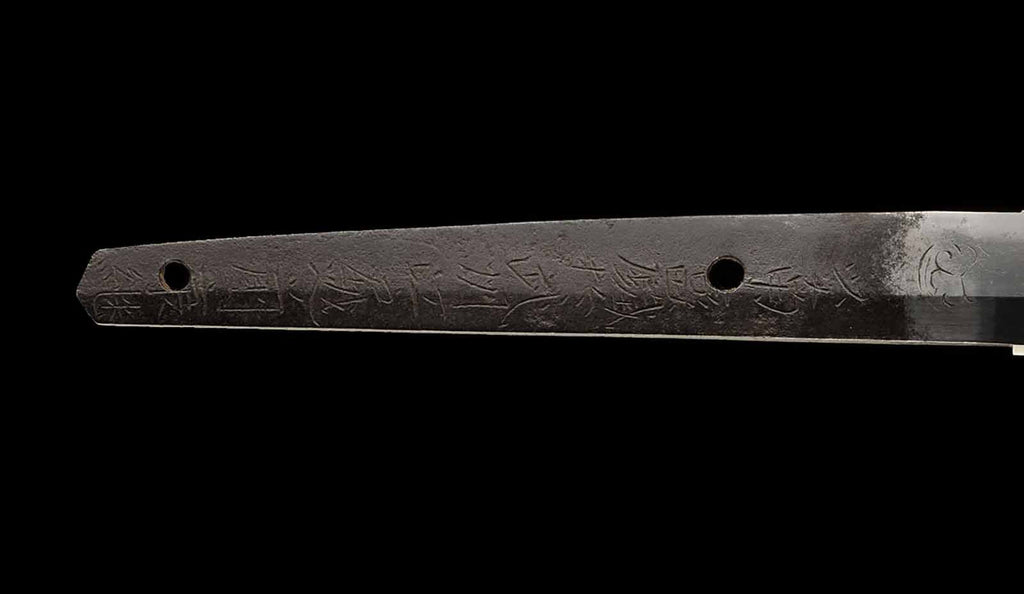Why focus on Mei?
Many Japanese swords have inscriptions on the tang. It is recorded that in the Nara period (710-794), a swordsmith’s name was required by law to be inscribed on the tang. However, it is said that the style we see today began in the late Heian period (794-1192) when the shape of swords changed from being straight to a curved shape known as wanto. Now let’s introduce the various types of inscriptions.
Omote-mei

The name of the swordsmith is engraved on the sashiomote (in the case of Uchigatana) or hakiomote (in the case of Tachi). In the old days, omote-mei was often engraved with two characters, and the number of characters gradually increased to include the place of residence and family name.
Tachi-mei
From the late Heian period to the early Muromachi period, Tachi were the main type of swords being produced, so the smith’s names were often engraved on the hakiomote, but there are exceptions, such as Sanjo Munechika, where the name is engraved on the hakiura.
Katana-mei

In the early Muromachi period (1392-1573), the style of battle changed from horseback to infantry, and swords also shifted from tachi to uchigatana. In this period, the number of letters to be engraved increased, and the name of the person who ordered the sword and a record of who the sword was made was also engraved.
Ura-mei

An inscription engraved on the hakiura for Tachi or on the sashiura for Uchigatana is called Ura-mei. In most cases, the date of production was engraved, but in rare cases, the smith’s name was also engraved. It is not clear when the custom of Ura-mei started, but many Bizen swords are engraved with inscriptions on the back of the tang, while Mino swords have few inscriptions on the back.
Shoji-mei

In addition to the swordsmith’s name, there are cases where the owner’s name was also engraved on the tang. The owner of the sword commissioned the swordsmith to make the sword, and when the swordsmith engraved his name, the owner's name was engraved at the same time. In other cases, the owner's name was engraved later on an older sword that already existed. The Shoji-mei can be found among swords made in the Muromachi period and swords in the late Edo period. This is probably due to the fact that the owners of the swords had often faced death during this turbulent period.
Tameshi-mei

The sharpness of a sword greatly affects the life of the samurai who owns it. In other words, a samurai would have been most concerned with how well his sword cut. Therefore, a method of testing the sharpness called tameshi-kenjutsu became popular in the late Muromachi period. The result of the test was engraved on the tang as an inscription, which is called Tameshi-mei. Tameshi-mei was often colored, and although some older swords had silver inlays, gold inlays were generally more common. Early Tameshi-mei were engraved with the number and part of the corpse cut and the date of the cutting. The corpses had hard and soft parts, depending on where they were cut, so each part was given a name. On the tang of Kanefusa's sword, there is Tameshi-mei that says Nakanishi Joko cut seven bodies in the ninth year of Enpo.
Zogan-mei

Zogan-mei is an inscription that is inlaid on the tang using other metals. Generally, inlaid inscriptions are made of gold or silver.
Shu-mei

Shu-mei is an inscription on the tang with vermilion-colored Urushi lacquer and was often used for Kiwame-mei. Sometimes, gold powders are used instead of vermilion-colored lacquer, in this case, it is called Kinpun-mei.
Orikaeshi-mei

When the tang was folded back, it is called Orikaeshi-mei. When a sword received Suriage or was shortened, the signature part of the tang would be cut off, but by folding that part back, the smith’s name could be kept. Because of it, the place and direction of the inscription are reversed.
Tanzaku-mei

When it was difficult to keep the inscription even if the sword was folded back, the original inscription was cut into strips and put on the tang. This process is called Tanzaku-mei, also known as Gaku-mei.
In this way, the Mei plays an important role in the appraisal of Japanese swords

Want to buy authentic Samurai swords directly from Japan? Then TOZANDO is your best partner!

3 comments
Mar 04, 2025 • Posted by Tozando Katana Shop
Thanks for your comments. It may be difficult to determine the history of the katana from the tang inscription alone. The best way is still to show it to an expert.
Mar 04, 2025 • Posted by Cool carissa
Informative,
And well constructed
Mar 04, 2025 • Posted by Heath
I have just inherited a Japanese sword and would like to find out what the inscription is on the tang of the handle.
Who should I talk to to find out more?
Leave a comment: